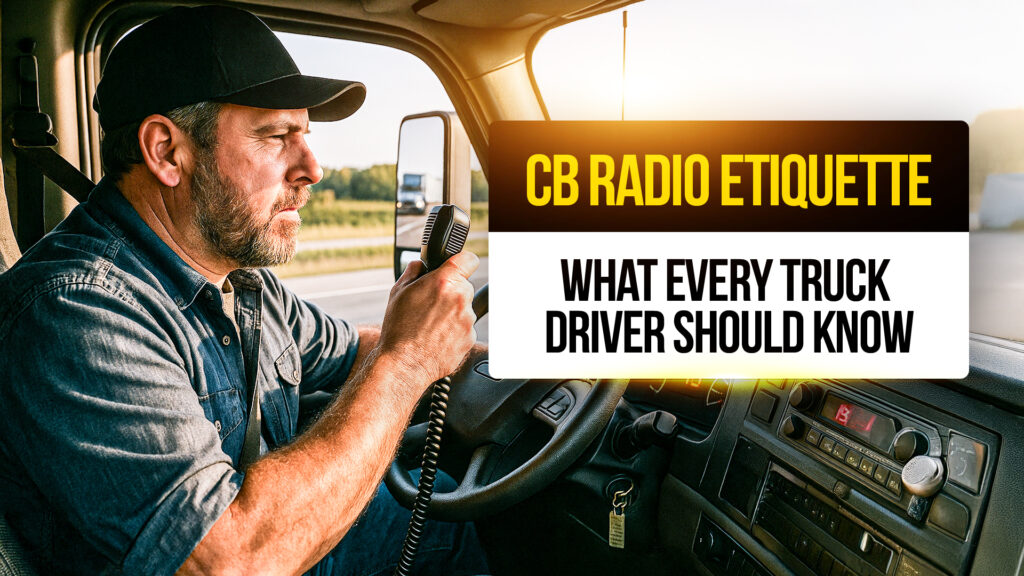
Whether you’re new behind the wheel or a road-tested veteran, CB radios are still one of the best tools for truckers to stay connected. From traffic alerts to weather updates to just passing the time, Citizens Band radio has long been part of trucking culture. But like any tool, there’s a right way to use it. In this post, we’ll break down CB radio etiquette, what it is, why it matters, and how to avoid being “that guy” on channel 19.
What Is CB Radio Etiquette, and Why Does It Matter?
CB radio etiquette is about respect, safety, and clear communication. Unlike your phone or personal radio, CB channels are shared. That means everything you say is public, and your words reflect on you.
CB radios are especially helpful for:
- Real-time road updates (wrecks, construction, roadblocks)
- Emergency communication when cell service is down
- Chatter and camaraderie with other drivers
- Weather warnings like black ice, high winds, or flooding
But when drivers don’t follow basic etiquette, it clutters the airwaves and can block important info.
CB Radio Etiquette 101: The Dos and Don’ts
Here are the golden rules to follow on the mic:
✅ DO:
- Keep it short and clear. Say what you need to, then release the mic.
- Use common CB lingo. Phrases like “10-4” (message received) and “Bear trap” (speed trap) help keep messages fast and clear.
- Listen before speaking. Avoid cutting off other drivers mid-transmission.
- Use channel 19 for highway comms, it’s the unofficial standard.
- Be respectful. Treat the channel like a shared tool, not your personal podcast.
❌ DON’T:
- Swear or go on rants. It’s not just rude—it can get you reported.
- Hog the channel. Long stories or nonstop talking blocks others from using it.
- Spread rumors. Stick to what you see firsthand (or heard from a trusted source).
- Use fake handles. Stay consistent so others know who you are.
What It Means for Your Job (and Reputation)
Your CB voice is part of your on-the-road identity. How you sound and act on the radio can impact how others treat you at truck stops, in convoys, or in emergencies.
Professional drivers know: you never know who’s listening. That friendly heads-up or calm voice during a backup? It gets noticed, and respected.
For newer drivers, learning CB etiquette is also a way to earn trust fast. It shows you’re serious, smart, and safety-focused, qualities carriers appreciate.
Drivers 1st Helps You Navigate More Than Just the Highway
If you’re new to trucking, or just trying to find a better fit, CB tips like these are just part of the puzzle. Drivers 1st exists to help drivers like you cut through the noise, whether it’s job listings, dispatch confusion, or trucking culture. We’re not here to push you, we’re here to help you make a smart move when you’re ready.
How to Take Action: Practice, Listen, and Level Up
Want to get better on the mic and more connected on the road? Here’s how:
- Listen more than you talk. You’ll pick up lingo and learn the rhythm.
- Practice short, useful updates. Keep it clear and calm.
- Ask other drivers. Most are happy to help you learn the ropes.
- Keep your gear clean. A cheap or busted mic can make you sound worse than you are.
→ Talk to a Driver Advocate (No Pressure)
Conclusion
CB radios still matter, and how you use them matters even more. By following basic etiquette, you keep the airwaves useful, safe, and professional. And in an industry where reputation travels faster than traffic, that kind of respect pays off.
Whether you’re ready to switch gears or just want to see what’s out there, Drivers 1st is here when you are. No pressure. Just better options.
For more updates and insights into the trucking world, stay tuned to Drivers1st.com!